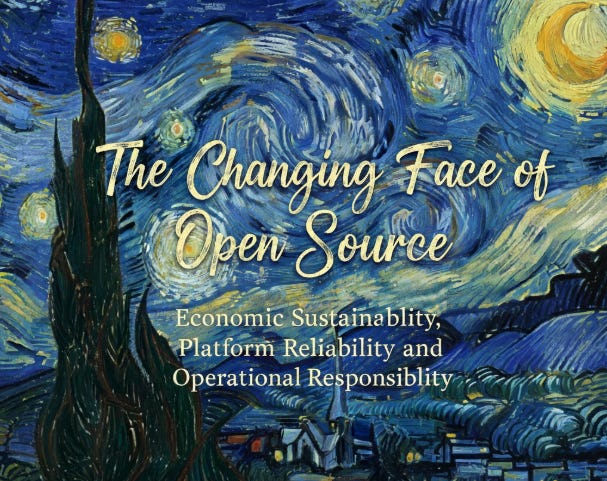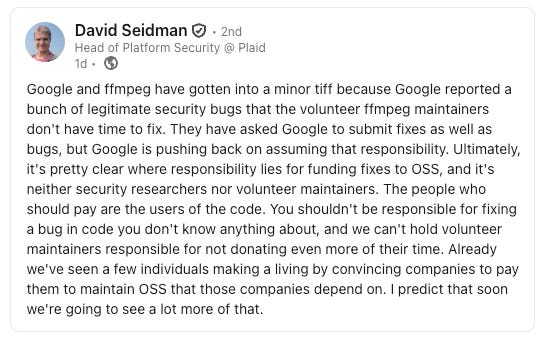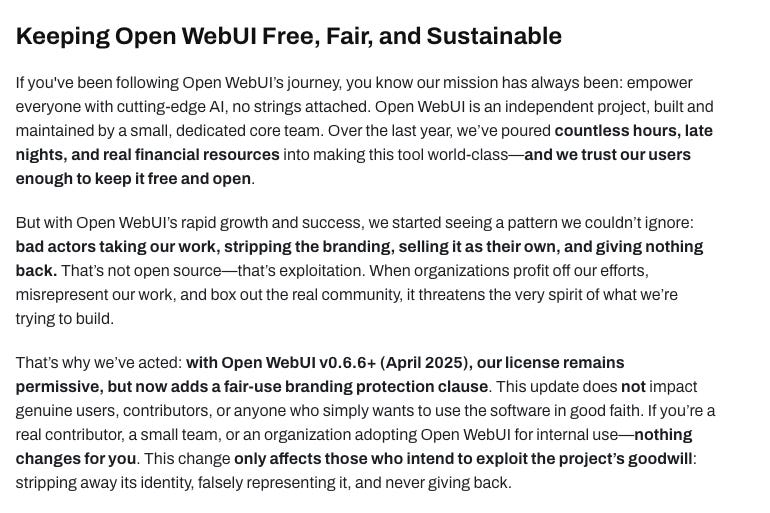The Changing Face of Open Source
Economic Sustainability, Platform Reliability and Operational Responsibility
Understanding Open Source Licenses
Before we talk about how open source itself is changing, it’s worth remembering what open actually means.
Licenses like MIT, Apache, and GPL define how code can be used, modified, and shared.
At its core, open source is built on permissions and trust:
You can use and modify the code (freedom).
You must credit and share improvements (responsibility).
There’s no warranty or liability (reality).
But over time, the meaning of “open” has started to blur, especially as companies build commercial products on top of it.
Three Faces of Modern Open Source
Not all open source is the same anymore. It helps to distinguish what “open” really means today:
1. Fully Open Source (Code + Tool)
Both the source code and core functionality are freely available. Anyone can run, modify, and self-host the entire stack.
Examples: OBS Studio, GIMP, Blender, PostgreSQL
Principle: Built by the community, sustained by the community.
2. Source-Available / Open Core
The core is open source, but advanced or cloud-integrated features are proprietary. Often includes “enterprise” editions, hosted services, or SaaS offerings.
Examples: Airbyte, Metabase, Superset
Principle: A balance between openness and monetization, practical but not pure.
3. Cloud-First / Commercial-Open
The repo might exist, but self-hosting is impractical. Features are tightly integrated with their hosted platform. You need to sign up, get an API key, or use their hosted cloud to access real functionality.
Examples: evidence, analytics startups, many AI-driven products
Principle: Open source as a growth strategy, not a philosophy.
Three Faces of OSS Challenges
From truly open community projects to “open” tools that live mostly in the cloud, the line between sharing and selling isn’t so clear anymore.
But there’s more to the story; When open source projects grow and millions start using them, they run into three real-world problems.
Economic sustainability
Preventing Free Riding
Open source may not have a price tag, but that doesn’t mean it’s cost-free.
Case : MinIO Docker Image Changes
This move by MinIO illustrates something we’ve been circling around: open‑source software may carry no price tag but that doesn’t mean it’s cost‑free. The moment a project becomes widely adopted (MinIO claims over 1 billion Docker image downloads and and originally used the Apache 2.0 license, which allowed users to freely use, modify, and redistribute the software. - 1 ) . they could have given advance notice, but open source is a two‑sided coin.
The burden of maintenance, security patches, documentation, and distribution logistics starts piling up. Someone has to pay for that work.
At the end of the day, companies will naturally drift toward commercially focused models, particularly when investments are involved.
https://news.ycombinator.com/item?id=45665452
Today, many “open source” projects aren’t truly open anymore. They often start as community-driven tools to gain traction but once they grow, a pricing wall appears, leaving early adopters with limited access and paywalled features.
We’re entering an era where open source has become more of a strategy than a philosophy. Startups use it to attract contributors and visibility, only to later pivot toward restrictive licensing or cloud-only versions. What started as a community experiment turns into a carefully planned business play and that shift is changing how we think about “free” software.
To maintain economic sustainability, companies leveraging open source should consider investing in the ecosystem whether by sponsoring development, hiring dedicated contributors, or adopting dual-licensing models. Aligning business incentives with community health ensures that popular tools remain well-supported, secure, and able to evolve without jeopardizing the businesses that rely on them.
Platform Reliability
The Engineer’s Dilemma
Case : Fivetran acquired dbt

The challenge is real for anyone building products or platforms on top of open source tools. Your business and processes depend on someone else’s library or roadmap, and when that code’s future suddenly becomes uncertain due to acquisitions, licensing changes, or shifts in maintainership, it introduces significant risk.
Take dbt, for instance. Widely adopted by analytics teams, the community now faces questions about how contributions to dbt Core will evolve and whether Fivetran’s integration roadmap will align with the needs of users ( shifting from Open Core to Commercial ) . Many data and analytics engineers are beginning to view dbt more as an templated SQL language than merely a tool or library.
The New Open Source Playbook
For example, look closely at the VC-funded SaaS world, and a familiar pattern emerges:
Launch open → release a free “core” product on GitHub to attract contributors.
Build traction → gain community validation, stars, blog mentions, and integrations.
Monetize → introduce “Pro” features, often tied to cloud-only offerings or usage-based pricing.
Lock-in → gradually shift innovation to the paid version while keeping the open-source repo minimally updated.
It’s not inherently bad, companies need to make money but it diverges from the original open source philosophy. Open source becomes a launchpad for business models, not a community-first philosophy.
Operational Responsibility
Who Pays for?
Case : Google & FFmpeg – Responsibility for Security bug fixes
The Google vs. FFmpeg case highlights a critical aspect of operational responsibility for businesses relying on open source software. Even when vulnerabilities are discovered, sometimes by well-resourced organizations, there is no guarantee they will be promptly fixed, as volunteer maintainers often lack the capacity or resources to address critical issues.
This creates a gap between identifying problems and ensuring their resolution, raising the question of who is responsible for maintaining and securing widely used open source components.
For companies building on such tools, it underscores the need to actively support, fund, or contribute to these projects rather than assuming volunteers will handle essential fixes for free. Operational responsibility in this context means planning for continuity, security, and reliability by taking a proactive role in sustaining the open source infrastructure that underpins your business.
Safeguarding Integrity
Sometimes the threat isn’t economics but exploitation.
Case : Open WebUI License
Open WebUI’s License update highlights how projects can act to defend the principles of free, fair, and sustainable software in today’s software economy.
While many open-source projects are free for genuine users and contributors, some face misuse by actors who strip branding, misrepresent work, or profit without giving back. To address this, projects can implement policies or clauses that:
Keep it Free: Ensure legitimate users and contributors can access and use the software without restriction.
Ensure Fairness: Protect the project’s identity and respect contributors’ efforts.
Maintain Sustainability: Preserve the long-term viability of the project by preventing commercial exploitation or misuse.
Staying True to the Open-Source Spirit
Amid the wave of commercialization in open source, a few projects continue to stand firm.
Some creators and foundations still honor the original open-source beliefs; building for the community, keeping tools free, and pushing innovation forward together.
Some projects not only stayed true to open-source principles but also shaped the software industry itself. Linux revolutionized operating systems and laid the foundation for modern servers, cloud computing, and embedded systems.
One of my personal favorites is OBS Studio, a truly community-driven tool for video recording and streaming. It’s polished, reliable, and completely free, yet powerful enough that both content creators and professionals rely on it daily.
The Apache Software Foundation is another shining example, sustaining critical open-source projects that power modern tech from Spark, Airflow, Hadoop and many more ensuring that the backbone of today’s data and infrastructure ecosystems remains open and community-led.
We can’t forget the early moves by Google, which set a precedent for openness. By releasing projects like Kubernetes, TensorFlow, and publishing groundbreaking research, Google helped shape the foundations of today’s cloud computing, AI, and mobile ecosystems showing how corporate involvement and open-source principles can coexist.
Community-driven projects like Neovim demonstrate the power of grassroots innovation, modernizing tools like Vim while staying fully open and driven by user contributions.
Even today, projects like LibreOffice or Blender continue to thrive by putting the community first, proving that building for users, not just profits, can create tools that last and innovate.
Open source isn’t just about free code. It’s about the freedom to build, learn, and share.
As developers, engineers, and users, it’s important to recognize and support the projects that still live up to the true spirit of open source: built transparently, sustained by the community, and freely available for everyone to innovate with.
Your likes and shares are the best rewards and keep me inspired to write more.






